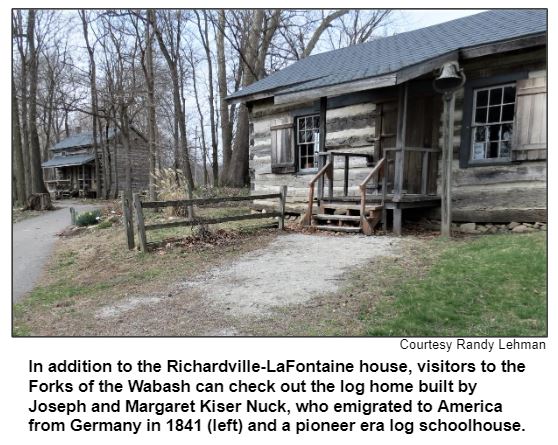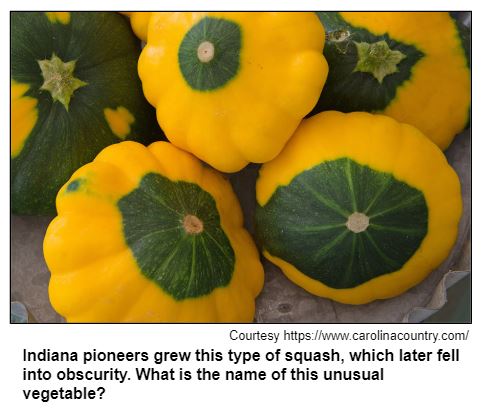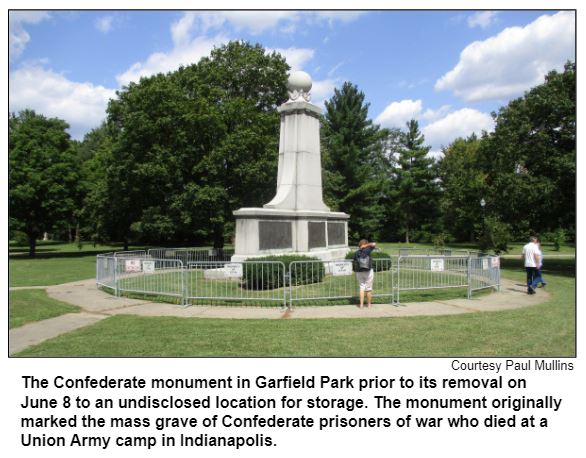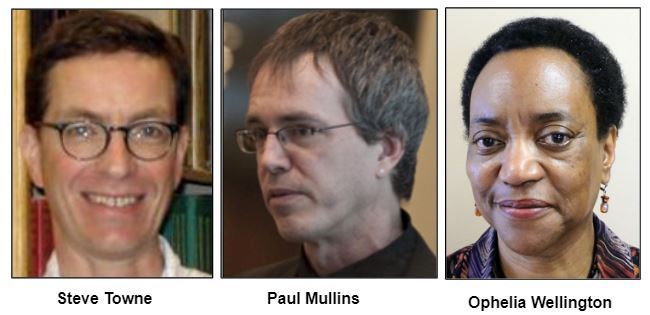
Saturdays, noon to 1 p.m. ET on WICR 88.7 FM.
Or stream audio live from anywhere on WICR Online!
You can listen to recent shows by clicking the podcast links below, or check out our extensive archive of past shows available as podcasts.
June 20, 2020
A second serving of foods of the pioneers
The table was overloaded when Hoosier History Live served up a show on topics related to the foods of the pioneers earlier this year. So during this show, we will savor additional, fresh aspects of what and how Indiana residents ate during the 1820s, '30s and '40s.
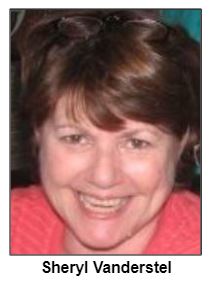
How was the corn grown in the pioneer era different from what's cultivated in Hoosier soil today?
Indianapolis-based food historian Sheryl Vanderstel will discuss those and other topics that we were not able to explore when she was our guest in April. In addition, Sheryl is planning to share insights about aspects of what she calls "food etiquette," of the pioneer era, customs ranging from "tableware to table settings, serving and meal manners."
"Table manners varied by social class and ethnic groups, just as they do today," she says.
Typically, every member of an Indiana pioneer household had a prescribed role in maintaining the family garden, Sheryl notes. In addition to vegetables and fruits, the gardens included herbs for cooking and medicinal use.
A native Hoosier whose ancestors were pioneers, Sheryl is a former assistant director of education at Conner Prairie Interactive History Park, where her duties included overseeing hearthside dinners and other food programs.
She has been involved in food programming at other historic sites and museums as well as educational seminars about historic foods. Sheryl is a board member of the Irvington Historical Society.
Roadtrip: Forks of the Wabash
Guest Roadtripper Terri Gorney of Fort Wayne suggests a visit to the Forks of the Wabash at the crossing point of US 24 and US 9 along the Wabash River in Huntington County. The "Forks" refer to the junction of the Wabash and Little River.
Terri says that the area is rich in history, dating as far back as Jean Baptiste Richardville (1761-1841) who built a home here. Richardsville's mother was Taucumwah, the sister of Chief Little Turtle, the great leader of the Miamis. Richardsville's father, as his name suggests, was a French-Canadian fur trader.
Richardville himself later became chief of the Miamis and his son-in-law, Francis LaFontaine, became the last real chief of the Miami people in 1841 with the passing of Richardville. LaFontaine would die at age 37 in 1847, poisoned - in some accounts - by tribe members forced to relocate west while their chief remained in Indiana.
Today the Richardville-LaFontaine home has been restored, along with a 19th century schoolhouse and cabin. Amenities include a garden with native flowers, trails to walk along the Wabash River and signs marking points of history.
Terri suggests that we take advantage of the site's picnic tables and shelter and bring a lunch to enjoy in the beautiful surroundings. And if you really love the outdoors, Terri says to be sure to explore the nearby Three Falls Trail at Salamonie State Forest, one of Indiana's natural treasures.
History Mystery
During a Hoosier History Live show earlier this year with food historian Sheryl Vanderstel, we discussed some food items that fell into obscurity after the pioneer era in Indiana. These "lost foods" included Jerusalem artichokes, salsify and a type of squash.
The squash is a summer squash that is quite colorful; an individual squash of this variety typically is both yellow and green. Like some of the other "lost foods," the mystery squash is being rediscovered by contemporary foodies, Sheryl reported.
Question: What is the name of the "lost" summer squash commonly grown during Indiana's pioneer era?
The call-in number is (317) 788-3314. Please do not call in to the show until you hear Nelson pose the question on the air, and please do not try to win if you have won any other prize on WICR during the last two months. You must be willing to give your first name to our engineer, you must answer the question correctly on the air and you must be willing to give your mailing address to our engineer so we can mail the prize pack to you.
The prizes this week are two tickets to the Eiteljorg Museum, courtesy of Visit Indy, and two tickets to Indy's Teeny Statue of Liberty Museum, courtesy of Tim and Julie's Another Fine Mess.
By the way, if your organization would like to offer History Mystery prizes, email admin@hoosierhistorylive.org. Good prizes are ideally vouchers or gift certificates that can be sent by postal service mail in a standard business envelope.
Nelson Price, host and historian
Molly Head, producer/general manager, (317) 927-9101
Mick Armbruster, associate producer
Cheryl Lamb, administrative manager
Richard Sullivan, senior tech consultant
Pam Fraizer, graphic designer
Garry Chilluffo, consultant
Please tell our sponsors that you appreciate their support!

 For organizational sponsorship, which includes logos, links, and voiced credits in the show and in podcasts, email support@hoosierhistorylive.org, or call (317) 927-9101 for information. Our podcast listens are increasing at a rate of 17% a month and we are being distributed on Indiana Memory and the National Digital Public Library. As we have always believed, the internet distribution of Hoosier History Live is taking us to the top! Thanks also to Visit Indy, Fraizer Designs, WICR-FM, Henri Pensis, Aaron Duvall, Kielynn Tally, Justin Clark, and many other individuals and organizations.
For organizational sponsorship, which includes logos, links, and voiced credits in the show and in podcasts, email support@hoosierhistorylive.org, or call (317) 927-9101 for information. Our podcast listens are increasing at a rate of 17% a month and we are being distributed on Indiana Memory and the National Digital Public Library. As we have always believed, the internet distribution of Hoosier History Live is taking us to the top! Thanks also to Visit Indy, Fraizer Designs, WICR-FM, Henri Pensis, Aaron Duvall, Kielynn Tally, Justin Clark, and many other individuals and organizations.
Thank you!
We'd like to thank the following recent, new and renewal contributors whose donations help make this show possible!
- Carl and Kathleen Widland
- Carol Bacon
- Rachel Perry
- Tom Swenson
- Dr. James Madison
- Stacia Gorge
- Dr. Geoffrey Golembiewski
- Clarke Kahlo
- Jim and Nancy Johnson
- Marion Wolen
- Robin Winston
- Peggy Hollingsworth
- Kathleen Angelone
- Jill Lough Chambers
- Jinsie Bingham
June 27, 2020 - coming up
Confederate monument in Indy and Camp Morton
Following the recent dismantling in an Indianapolis park of a Confederate monument that originally marked the graves of prisoners of war who died at a Union Army camp, Hoosier History Live will explore the historic context of various aspects of the controversy.
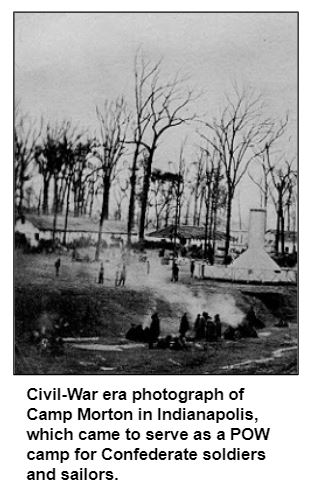
Civil War historian Steve Towne, the author of Surveillance and Spies in the Civil War (Ohio University Press) and other books and award-winning articles about the Civil War, is an archivist at IUPUI. His colleague Paul Mullins, an anthropology professor, has researched the Confederate monument, which he notes was placed initially at Greenlawn Cemetery in 1909.
Greenlawn, the first major public cemetery in Indianapolis, was located near the White River and Kentucky Avenue, a site that was prone to flooding and later became increasingly industrialized. The monument, funded by the federal government, was a mass marker for 1,616 Confederate POWs whose remains could not be identified individually. Their remains were moved to Crown Hill Cemetery, Greenlawn's successor as the city's major graveyard; the reburial site at Crown Hill is known as Confederate Mound.
Along with Steve Towne and Paul Mullins, our guests during the show will include Ophelia Wellington, founder of Freetown Village, a living history museum she created in 1982 to teach African-American history.
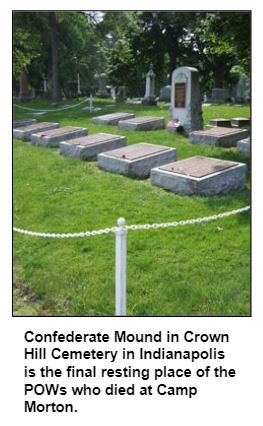
During the course of the war, Camp Morton primarily served as a POW camp for Confederate soldiers and sailors; by the end of the war, about 1,700 had died there. Today, much of the Herron-Morton Place Neighborhood is on the site of Camp Morton.
With the moves of the POWs' remains, many could not be identified. The relocation of the federally-funded monument (with a metal plate at the base that lists the names of the POWs) from Greenlawn to Garfield Park was advocated by the Southern Club of Indianapolis, which Paul Mullins will describe during our show.
The placement of the monument in a public park in the late 1920s has been controversial for several years. Since the June 8 dismantling, it has been stored at an undisclosed location.
It is not the only Confederate monument, memorial or marker in Indiana. According to the Indiana Historical Bureau, a state historic marker in the Franklin County town of Laurel, birthplace of a Confederate brigadier general, is under review for "misleading and inaccurate statements" as well as the lack of proper historic context on the signage. In Terre Haute, an obelisk at Woodlawn Cemetery memorializes eleven Confederates who died in a POW camp in the city.
© 2020 Hoosier History Live. All rights reserved.
|





